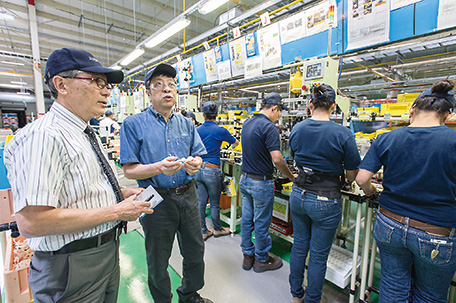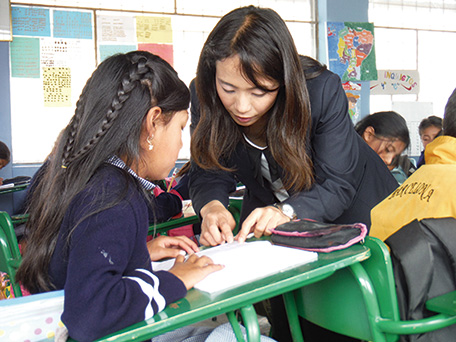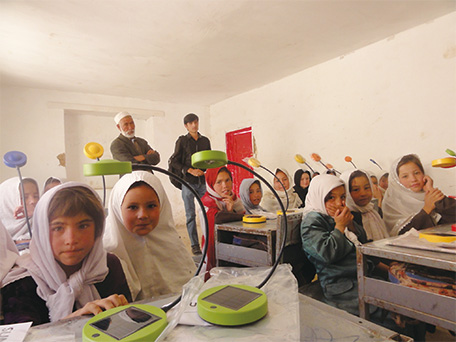Chapter 2 Specific Initiatives of Japan's Official Development Assistance

The chief advisor of the Project for Automotive Supply Chain Development in Mexico, Mr. Hiromi Ikehata, inspecting a manufacturing line of automotive parts, such as door locks, in Monterrey City, Mexico. (Photo: Kenshiro Imamura / JICA)
This chapter discusses specific initiatives of the official development assistance (ODA) that Japan provides around the world.
Section 1 further breaks down the measures for each priority issue, namely, “poverty reduction,” “sustainable growth,” “addressing global issues,” and “peacebuilding,” and introduces Japan's approach to each area.
The world is faced with largely different economic and social environments and cultures, and confronts various kinds of issues depending on the region and country. Section 2 presents specific examples of Japan's development cooperation by region. The eight regions outlined are: East Asia, South Asia, Central Asia and the Caucasus, the Middle East and North Africa, Sub- Saharan Africa, Latin America and the Caribbean, Oceania, and Europe.
The Japanese government has provided development cooperation in consideration of the principles of the United Nations Charter, achieving a balance between environmental protection and development, avoiding any use of ODA for military purposes, preventing the proliferation of terrorism and weapons of mass destruction, promoting democratization, and protecting basic human rights and freedoms, and based on a comprehensive assessment of the developing country's demand for assistance, socio-economic conditions, and Japan's bilateral relations with the recipient country. Section 3 provides a concrete explanation of the factors that are taken into account for the implementation of Japan's ODA.
Finally, Section 4, introduces the system of implementation of Japan's ODA and a series of reform measures for providing more efficient and effective ODA, which are divided into the following three categories: “System of Formulation and Implementation of Development Cooperation Policy,” “Increasing Public Participation,” and “Requirements for Implementation of Strategic and Effective Development Cooperation.”
Section 1 Measures for Each Priority Issue
This section introduces Japan's recent efforts for the four priorities of poverty reduction, sustainable growth, addressing global issues, and peacebuilding.
1. Poverty Reduction
(1) Education
Education plays an important role in the socio-economic development that is needed for poverty reduction. It also enables individuals to develop their own potential and capability, as well as to live with dignity. Education fosters understanding of other people and different cultures, and forms the foundation for peace. Throughout the world, however, approximately 58 million children cannot go to school. Approximately 900 million adults do not have minimum literacy (the ability to read and write short, simple sentences), about 60% of whom are women.(Note 1) In order to improve this situation, the international community has been working to achieve Education for All (EFA)*. In September 2012, the UN Secretary-General announced the Education First* initiative and called for the efforts of the international community to promote the spread of education.
<Japan's Efforts>

A Japan Overseas Cooperation Volunteer (primary school teacher), Ms. Akiyo Kaneko, teaching mathematics in Cotopaxi Province, located in the central Ecuador. (Photo: Kyoko Hayashi)

Zambian students using experiment instruments for the first time at the Mobile Science Laboratory that was built through the Grant Aid for Poverty Reduction Strategies (education). (Photo: Junko Kabashima)
Emphasizing “nation-building” and “human resources development,” Japan has been providing developing countries with a broad range of support for education, including the enhancement of basic education*, higher education, and vocational training. In 2002, Japan announced the “Basic Education for Growth Initiative (BEGIN).” In accordance with BEGIN, Japan provides assistance that combines the equipment and facilities aspect, such as constructing schools, with the knowledge and expertise aspect, such as training of teachers, with priority emphasis on (i) ensuring access to education, (ii) improving the quality of education, and (iii) improving education policies and educational administration systems.
In 2010, Japan released “Japan's Education Cooperation Policy 2011-2015,” as its new education cooperation policy to be implemented from 2011 through 2015, the target date to achieve EFA and the Millennium Development Goals (MDGs). (MDG 2: Achieve universal primary education, MDG 3: Promote gender equality and empower women.) The new policy promises that over five years from 2011 Japan will provide $3.5 billion, focusing its assistance on (i) basic education; (ii) post-basic education (secondary education following the completion of primary education, vocational training and education, higher education); and (iii) education for vulnerable countries affected by conflicts or disasters. Japan aims to establish quality educational environment, paying attention to alienated children as well as vulnerable countries, and other areas where it is difficult to deliver the assistance, and has been providing assistance to enable individuals who have completed primary education to continue further education. Through this assistance, at least 7 million children will have access to a high-quality educational environment. In addition, Japan has proposed “School for All,” a basic educational aid model that is designed to provide access to quality education for all children. As part of its new policy, working together with schools, local communities, and governments, Japan is engaged to improve the learning environment in a variety of aspects such as (i) quality education (improving the quality of teachers, etc.); (ii) safe learning environment (provision of school facilities, health and sanitation); (iii) school based management; (iv) schools open to the local community; and (v) inclusive education for children disadvantaged in attending school due to poverty, gender discrimination, disability, and others. Japan attended the Global EFA Meeting held in Oman in May 2014, and is actively contributing to the discussions towards establishing the post-2015 education agenda*, which will serve as the education targets beyond 2015.
Also, Japan has been actively participating in efforts to discuss and reform the Global Partnership for Education (GPE)*, which lays out the international framework for achieving universal primary education by 2015, for example, by serving as a board member in 2014. Furthermore, Japan's contributions to GPE funds from FY2007 to FY2013 totaled approximately $16 million.
Regarding initiatives for Africa, at the Fifth Tokyo International Conference on African Development (TICAD V) held in June 2013, Japan announced that it would provide high-quality educational environments for an additional 20 million children over the course of five years starting in 2013, through the expansion of support for math and science education improvement and school management improvement projects. Japan is steadily implementing these initiatives.

A girl carrying text books and waiting for her class in a school in Bangladesh. (Photo: Eiko Kusuyama)

A Japan Overseas Cooperation Volunteer (mathematics and science teacher), Mr. Motohiko Mizutani, walking around the classroom to check each student during a mathematics lesson at the Kijjabwemi Secondary School, which is two and a half hours bus ride from Kampala, the capital city of Uganda. (Photo: Kazuko Marui / JICA Uganda Office)

“Light for Education” project promoted by Save the Children Japan. Solar lanterns that can be charged by sunlight are used in Afghanistan. (Photo: Save the Children (Bamiyan Office))
Furthermore, in order to improve the substance and quality of education in the Asia-Pacific region, Japan is contributing to a trust fund to the United Nations Educational, Scientific and Cultural Organization (UNESCO) to implement projects for improving the management capacity of community learning centers for literacy education, among other purposes.
Afghanistan is a country with an estimated illiterate population of approximately 11 million (about 40% of the population) due to the impact of approximately three decades of civil war. The Government of Afghanistan aims to provide 3.6 million people with literacy education by 2014. Since 2008, Japan has contributed to the promotion of literacy education in Afghanistan with a total of approximately ¥5.3 billion in grant aid through the UNESCO to provide literacy education to 1 million people in 100 districts of 18 provinces in Afghanistan.
In recent years, Japan has been promoting transnational networking of higher education institutions and joint research projects among neighboring countries. Japan also supports human resources development in developing countries by accepting international students to Japanese institutions of higher education in accordance with the “300,000 International Students Plan” and through other such measures.
In addition, Japan strives to make it easier for Japanese in-service teachers to go overseas as Japan Overseas Cooperation Volunteers (JOCV) under the Special Program for School Teachers*. In-service teachers dispatched to developing countries contribute to education and social development in their dispatched countries, and make use of their experiences in the field of Japanese education after their return.
- *EFA: Education for All
- Education for All (EFA) is an international movement that aims at ensuring everyone in the world has the opportunity to receive at least a basic education. The five main organizations involved in EFA are the United Nations Educational, Scientific and Cultural Organization (UNESCO), the World Bank, the United Nations Development Programme (UNDP), the United Nations Children's Fund (UNICEF), and the United Nations Population Fund (UNFPA), with UNESCO serving as the overall coordinator.
- *Education First
- Education First is an initiative on education announced by the UN Secretary-General in September 2012. Laying foundations for the fundamental right of education in social, political, and developmental agendas, it promotes international efforts intended to spread education. In particular, it prioritizes school attendance of all children, the improvement of education quality, and fostering global citizenship for the individuals to participate actively in the efforts to tackle global issues.
- *Basic education
- Basic education is educational activities designed to enable individuals to acquire the knowledge, values, and skills needed to live. It mainly refers to primary education, lower secondary education (equivalent to the Japanese junior high schools), pre-school education, and adult literacy education.
- *GPE: Global Partnership for Education
- GPE refers to a framework for international cooperation established under the leadership of the World Bank in 2002, in order to achieve universal primary education by 2015 that is included in the MDGs and the EFA Dakar goals (formerly known as FTI: Fast Track Initiative).
- *Post-2015 education agenda
- 2015 is the deadline to achieve the EFA Dakar goals aimed at education for all, adopted at the World Education Forum in Dakar, Senegal in 2000. The post-2015 education agenda outlines the education targets that will succeed the Dakar goals. It is expected to be adopted at the World Education Forum 2015 in Incheon, the Republic of Korea in May 2015.
- *JOCV under the Special Program for School Teachers
- The program is designed to encourage in-service teachers to participate in international cooperation. Teachers who are recommended by MEXT to JICA are exempt from the preliminary technical test, and the period of dispatch is set for two years (compared to the usual cases which are for two years and three months), beginning in April and ending in March, to match the Japanese school year.
- Note 1: Source: “The Millennium Development Goals Report 2014” (UN)
| Zambia
Strengthening Teachers' Performance and Skills through School-based Continuing Professional Development Project
Technical Cooperation Project (October 2011 – Ongoing (December 2015))

Administrative officials of education and teachers, learning the methods of classroom research and study materials research. (Photo: Kazuyoshi Nakai)
Zambia, a landlocked country in Southern Africa, has a high net enrollment rate1 in basic education as well as a high adult literacy rate of 91.4% and 70.9%, respectively. Nevertheless, according to a 2010 study which compared students' achievement levels in Southeastern Africa, the mathematics ability of Grade 6 students in Zambia ranked in last place among the 14 participating countries. As such studies have shown, students' achievement level still remains low in Zambia. To improve the achievement level, it is considered that the quality of the schooling that students receive needs to be addressed. In a science or mathematics class in Zambia, typically students simply copy down model answers that the teacher writes on the blackboard or learn only one method of solving in a mechanical way. Teaching styles that encourage students to think deeply to come up with creative solutions are uncommon. In providing support, Japan perceived that this style of schooling needed to be transformed in order to improve the science and mathematics abilities of students.
With a view to promoting education that encourages students' creative thinking, in 2005, Japan launched a technical cooperation project in Zambia, the “School-Based Continuing Professional Development” (SBCPD) program, which is based on the peer learning method among teachers that is adopted throughout Japan. Under this project, Japan supports initiatives in which teachers observe each other's actual lessons and afterwards discuss how to better conduct their lessons. Through this project, Zambian teachers learned about problem-solving and inquiry-based teaching approaches that are practiced in the classes in Japan. The effects were instantly manifested. Students' pass rate for the science and biology graduation exam in the target areas increased from 53.7% to 62.6% and from 46.5% to 77.0%, respectively. Japan is now providing technical cooperation to scale up this program to schools throughout Zambia. Approximately 38,000 teachers at approximately 2,100 schools are currently studying lesson techniques.
It is expected that this project will continue to enhance the teaching techniques of teachers at schools nationwide, and increase students' learning capacities and desire to learn not only science and mathematics but also other subjects. It is hoped that such cooperation will contribute to fostering many talents who will play an active role in the development of Zambia's economy and society in the future.
(As of August 2014)
*1 Net enrollment rate: The ratio of students who are actually enrolled in school (who belong to the official age group for a given level of education) to the total population of the corresponding school age.
| Cameroon
The 5th Project for Construction of Primary Schools
Grant Aid (July 2011 – May 2014)

Students taking notes during the lesson. (Photo: JICA)
The national budget deficits that Cameroon experienced from the late 1980s to the early 1990s left the school facilities vacant, which consequently deteriorated the educational environment. Subsequently, in 2000, Cameroon took a step to make primary education free of charge. However, this time, the Government of Cameroon was not able to respond to the growing number of students, and there were not enough school facilities. Lack of a sufficient number of desks and chairs, unsafe school buildings, and classes conducted with insufficient equipment resulted in children dropping out of schools.
Supporting Cameroon's policy agenda aiming to bridge the regional gap and to improve the quality of the primary education, Japan provided a grant aid to improve the learning environment. Targeting the northeastern region where the environment is poorest in the country, the project constructed a total of 202 classrooms in 31 schools and provided the necessary educational equipment. As a result, approximately 12,000 children now receive education in an adequate environment.
Since 1997, Japan has assisted Cameroon in constructing primary schools in 5 phases. As a result, a total of 281 schools and 1,533 classrooms were built in all 10 regions. In addition, Japan has been supporting Cameroon through the deployment of Japan Overseas Cooperation Volunteers (JOCV) from the education sector while providing training opportunities in Japan and other countries in order to continuously improve their quality of education.
